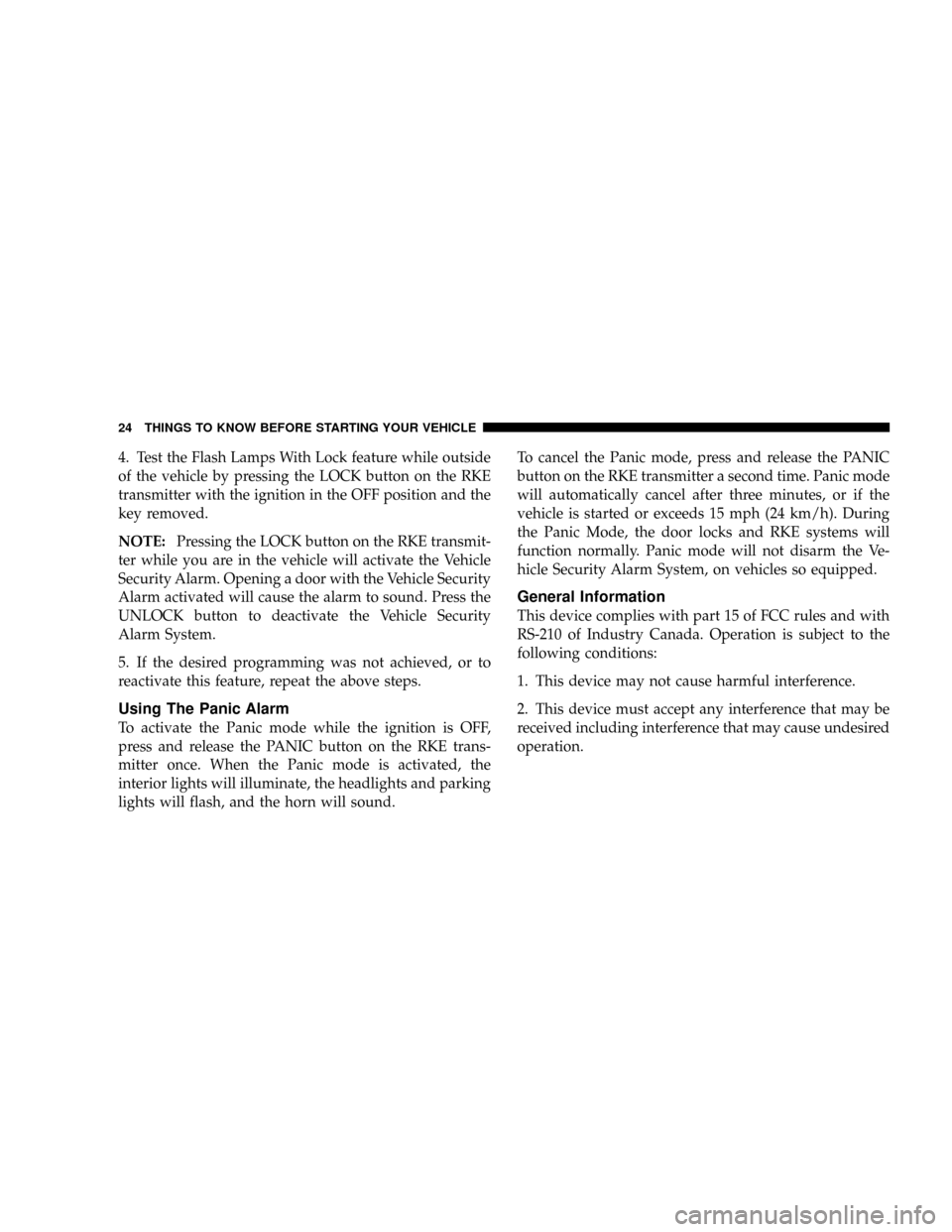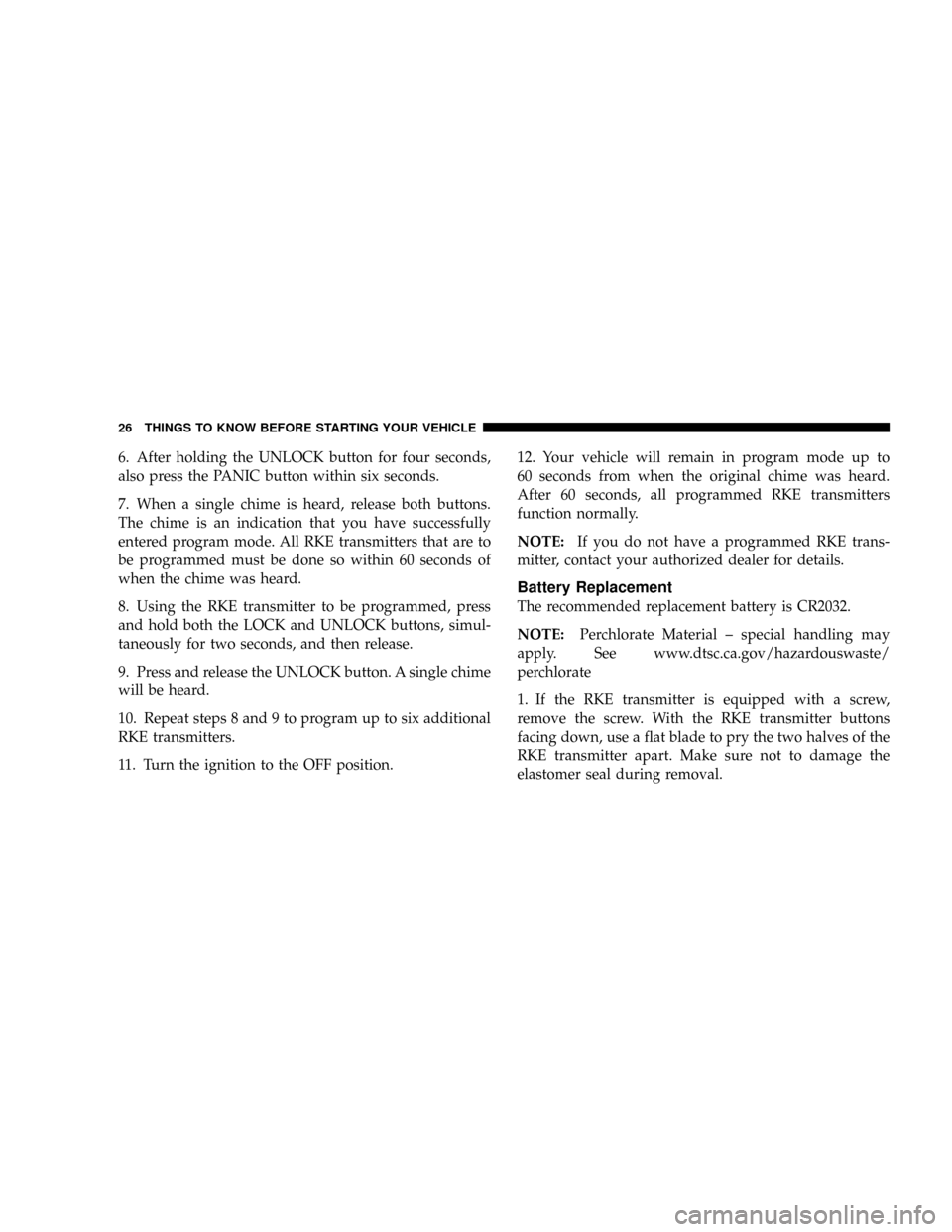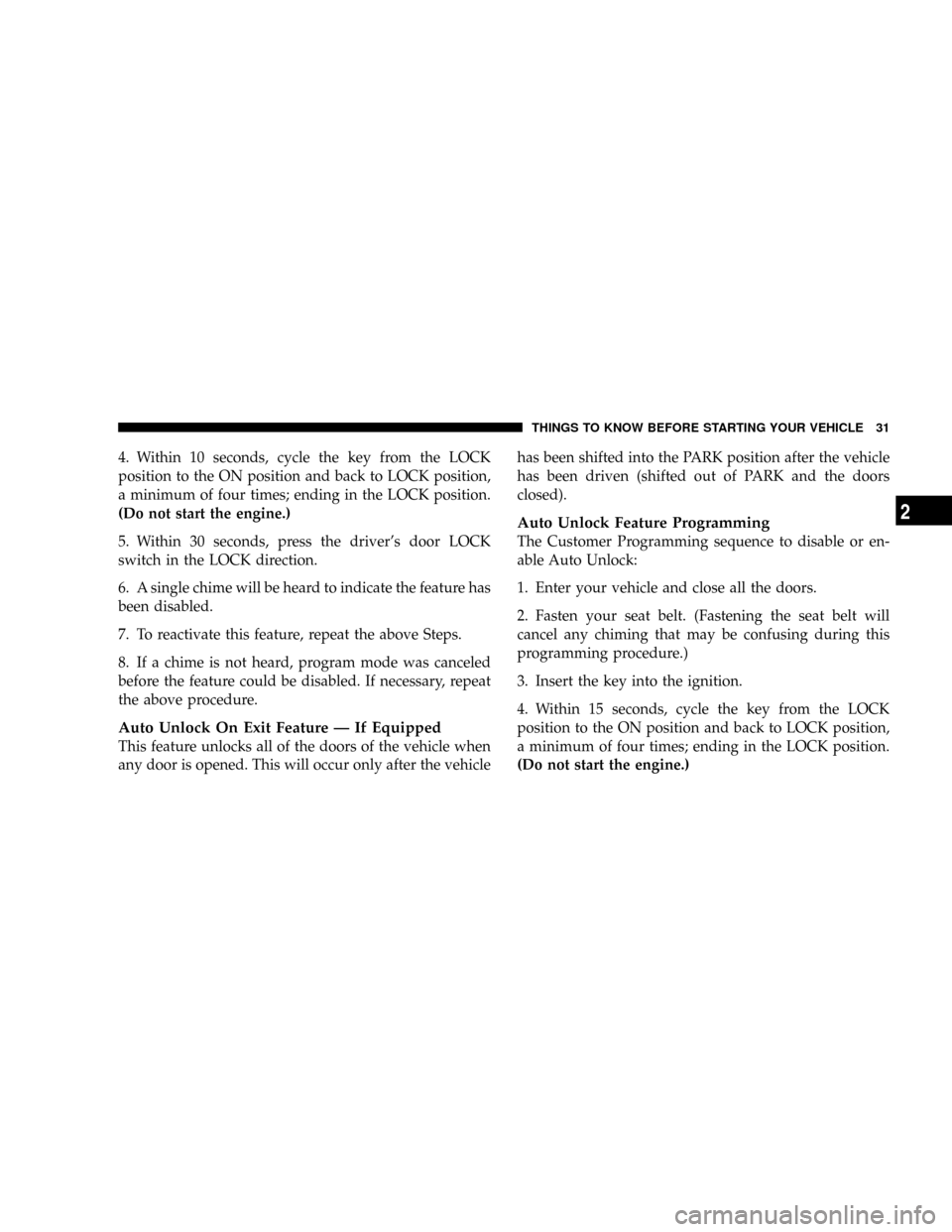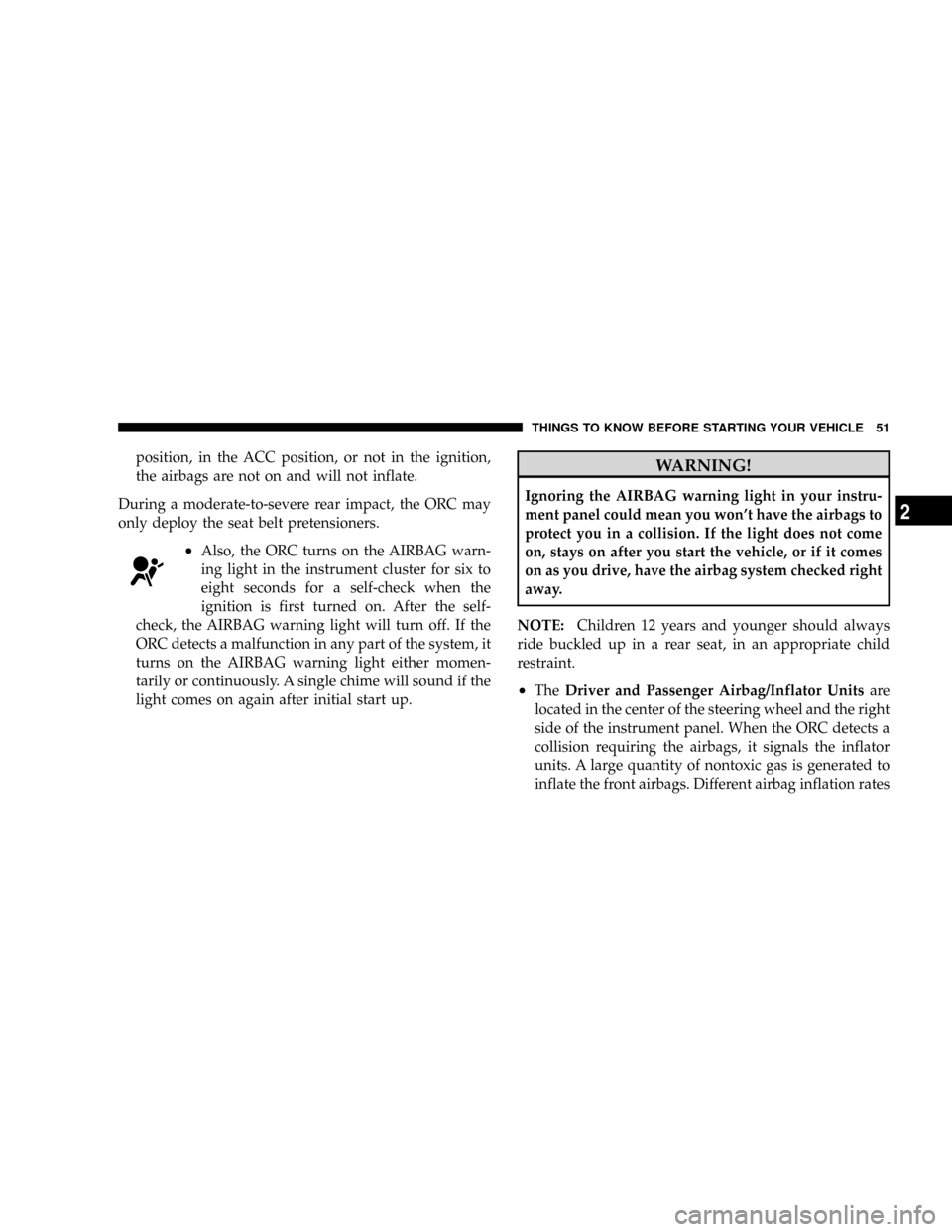2009 DODGE DAKOTA ECO mode
[x] Cancel search: ECO modePage 22 of 449

exit alarming mode, press the RKE transmitter UNLOCK
button or start the vehicle with a programmed Sentry
Keyt.
The Vehicle Security Alarm system is designed to protect
your vehicle; however, you can create conditions where
the system will arm unexpectedly. If you remain in the
vehicle and lock the doors with the RKE transmitter, the
alarm will sound when you pull the door handle to exit.
NOTE:You may accidentally activate the Vehicle Secu-
rity Alarm System (horn sounds and lights flash) by
entering the vehicle without using the RKE transmitter to
unlock the door(s). The system can be disarmed with the
RKE transmitter unlock button or by inserting a pro-
grammed Sentry Keytinto the ignition and turning the
key to the ON position.ILLUMINATED ENTRY
Vehicles Equipped With Power Door Locks
All interior lights will illuminate in the vehicle when the
doors are unlocked using the Remote Keyless Entry
(RKE) transmitter.
The interior lights will remain on for 30 seconds after the
last door is closed, or until all doors are closed and either
the ignition is turned to the ON position or a RKE
transmitter LOCK button is pressed.
There is also a battery saver feature that will turn the
interior lights off after eight minutes if the ignition is OFF
and a door is left open or the dimmer control is in the
interior lights ON position.
20 THINGS TO KNOW BEFORE STARTING YOUR VEHICLE
Page 26 of 449

4. Test the Flash Lamps With Lock feature while outside
of the vehicle by pressing the LOCK button on the RKE
transmitter with the ignition in the OFF position and the
key removed.
NOTE:Pressing the LOCK button on the RKE transmit-
ter while you are in the vehicle will activate the Vehicle
Security Alarm. Opening a door with the Vehicle Security
Alarm activated will cause the alarm to sound. Press the
UNLOCK button to deactivate the Vehicle Security
Alarm System.
5. If the desired programming was not achieved, or to
reactivate this feature, repeat the above steps.
Using The Panic Alarm
To activate the Panic mode while the ignition is OFF,
press and release the PANIC button on the RKE trans-
mitter once. When the Panic mode is activated, the
interior lights will illuminate, the headlights and parking
lights will flash, and the horn will sound.To cancel the Panic mode, press and release the PANIC
button on the RKE transmitter a second time. Panic mode
will automatically cancel after three minutes, or if the
vehicle is started or exceeds 15 mph (24 km/h). During
the Panic Mode, the door locks and RKE systems will
function normally. Panic mode will not disarm the Ve-
hicle Security Alarm System, on vehicles so equipped.
General Information
This device complies with part 15 of FCC rules and with
RS-210 of Industry Canada. Operation is subject to the
following conditions:
1. This device may not cause harmful interference.
2. This device must accept any interference that may be
received including interference that may cause undesired
operation.
24 THINGS TO KNOW BEFORE STARTING YOUR VEHICLE
Page 28 of 449

6. After holding the UNLOCK button for four seconds,
also press the PANIC button within six seconds.
7. When a single chime is heard, release both buttons.
The chime is an indication that you have successfully
entered program mode. All RKE transmitters that are to
be programmed must be done so within 60 seconds of
when the chime was heard.
8. Using the RKE transmitter to be programmed, press
and hold both the LOCK and UNLOCK buttons, simul-
taneously for two seconds, and then release.
9. Press and release the UNLOCK button. A single chime
will be heard.
10. Repeat steps 8 and 9 to program up to six additional
RKE transmitters.
11. Turn the ignition to the OFF position.12. Your vehicle will remain in program mode up to
60 seconds from when the original chime was heard.
After 60 seconds, all programmed RKE transmitters
function normally.
NOTE:If you do not have a programmed RKE trans-
mitter, contact your authorized dealer for details.
Battery Replacement
The recommended replacement battery is CR2032.
NOTE:Perchlorate Material ± special handling may
apply. See www.dtsc.ca.gov/hazardouswaste/
perchlorate
1. If the RKE transmitter is equipped with a screw,
remove the screw. With the RKE transmitter buttons
facing down, use a flat blade to pry the two halves of the
RKE transmitter apart. Make sure not to damage the
elastomer seal during removal.
26 THINGS TO KNOW BEFORE STARTING YOUR VEHICLE
Page 33 of 449

4. Within 10 seconds, cycle the key from the LOCK
position to the ON position and back to LOCK position,
a minimum of four times; ending in the LOCK position.
(Do not start the engine.)
5. Within 30 seconds, press the driver's door LOCK
switch in the LOCK direction.
6. A single chime will be heard to indicate the feature has
been disabled.
7. To reactivate this feature, repeat the above Steps.
8. If a chime is not heard, program mode was canceled
before the feature could be disabled. If necessary, repeat
the above procedure.
Auto Unlock On Exit Feature Ð If Equipped
This feature unlocks all of the doors of the vehicle when
any door is opened. This will occur only after the vehiclehas been shifted into the PARK position after the vehicle
has been driven (shifted out of PARK and the doors
closed).
Auto Unlock Feature Programming
The Customer Programming sequence to disable or en-
able Auto Unlock:
1. Enter your vehicle and close all the doors.
2. Fasten your seat belt. (Fastening the seat belt will
cancel any chiming that may be confusing during this
programming procedure.)
3. Insert the key into the ignition.
4. Within 15 seconds, cycle the key from the LOCK
position to the ON position and back to LOCK position,
a minimum of four times; ending in the LOCK position.
(Do not start the engine.)
THINGS TO KNOW BEFORE STARTING YOUR VEHICLE 31
2
Page 34 of 449

5. Within 30 seconds, press the driver's door LOCK
switch in the UNLOCK direction.
6. A single chime will sound to indicate the feature has
been changed.
7. To reactivate the feature, repeat the above Steps.
8. If a chime is not heard, program mode was canceled
before the feature could be changed. If necessary, repeat
the above procedure.
Child Protection Door Lock
To provide a safer environment for children riding in the
rear seat, the rear doors of your vehicle have the child-
protection door lock system.
Child Lock Lever
32 THINGS TO KNOW BEFORE STARTING YOUR VEHICLE
Page 53 of 449

position, in the ACC position, or not in the ignition,
the airbags are not on and will not inflate.
During a moderate-to-severe rear impact, the ORC may
only deploy the seat belt pretensioners.
²Also, the ORC turns on the AIRBAG warn-
ing light in the instrument cluster for six to
eight seconds for a self-check when the
ignition is first turned on. After the self-
check, the AIRBAG warning light will turn off. If the
ORC detects a malfunction in any part of the system, it
turns on the AIRBAG warning light either momen-
tarily or continuously. A single chime will sound if the
light comes on again after initial start up.
WARNING!
Ignoring the AIRBAG warning light in your instru-
ment panel could mean you won't have the airbags to
protect you in a collision. If the light does not come
on, stays on after you start the vehicle, or if it comes
on as you drive, have the airbag system checked right
away.
NOTE:Children 12 years and younger should always
ride buckled up in a rear seat, in an appropriate child
restraint.
²TheDriver and Passenger Airbag/Inflator Unitsare
located in the center of the steering wheel and the right
side of the instrument panel. When the ORC detects a
collision requiring the airbags, it signals the inflator
units. A large quantity of nontoxic gas is generated to
inflate the front airbags. Different airbag inflation rates
THINGS TO KNOW BEFORE STARTING YOUR VEHICLE 51
2
Page 72 of 449

WARNING!
An incorrectly anchored tether strap could lead to
seat failure and injury to the child. In a collision, the
seat could come loose and allow the child to crash
into the inside of the vehicle or other passengers, or
even be thrown from the vehicle. Use only the anchor
positions directly behind the child restraint to secure
a child restraint top tether strap. See your authorized
dealer for help, if necessary.
Transporting Pets
Airbags deploying in the front seat could harm your pet.
An unrestrained pet will be thrown about and possibly
injured, or injure a passenger during panic braking or in
a collision. Pets should be restrained in the rear seat in
pet harnesses or pet carriers that are secured by seat belts.
ENGINE BREAK-IN RECOMMENDATIONS
A long break-in period is not required for the engine in
your vehicle.
Drive moderately during the first 300 miles (500 km).
After the initial 60 miles (100 km), speeds up to 50 or
55 mph (80 or 90 km/h) are desirable.
While cruising, brief full-throttle acceleration within the
limits of local traffic laws, contributes to a good break-in.
Wide-open throttle acceleration in low gear can be detri-
mental and should be avoided.
The engine oil installed in the engine at the factory is a
high-quality energy conserving type lubricant. Oil
changes should be consistent with anticipated climate
conditions under which vehicle operations will occur.
The recommended viscosity and quality grades are
70 THINGS TO KNOW BEFORE STARTING YOUR VEHICLE
Page 79 of 449

mTilt Steering Column................... 131
mElectronic Speed Control Ð If Equipped...... 132
NTo Activate......................... 133
NTo Set At A Desired Speed.............. 133
NTo Deactivate....................... 133
NTo Resume Speed.................... 133
NTo Vary The Speed Setting.............. 134
NTo Accelerate For Passing............... 134
mOverhead Console..................... 135
NCourtesy/Reading Lights............... 136
mCompass/Temperature Mini-Trip Computer . . . 136
NUS/M Button....................... 137
NReset Button........................ 137NStep Button......................... 138
NAverage Fuel Economy (AVG ECO)........ 138
NDistance To Empty (DTE)............... 138
NTrip Odometer (ODO)................. 139
NElapsed Time (ET).................... 139
NC/T Button......................... 139
NGlobal Reset........................ 140
NCompass/Temperature Display........... 140
NAutomatic Compass Calibration.......... 140
NManual Compass Calibration............ 141
NTo Put Into a Calibration Mode........... 141
NOutside Temperature.................. 142
UNDERSTANDING THE FEATURES OF YOUR VEHICLE 77
3